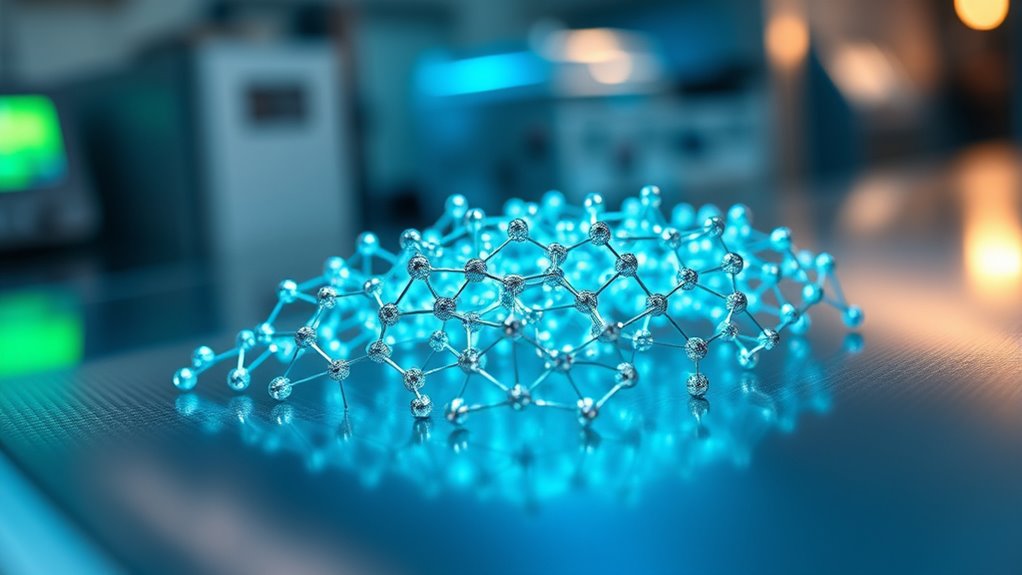Nanotechnology in industry lets you create materials and products at the nanoscale that boost strength, efficiency, and sustainability. It transforms manufacturing, construction, energy, and environmental management by improving everything from stronger materials and smarter sensors to cleaner production and renewable energy solutions. These tiny materials enhance durability, reduce environmental impacts, and enable innovative processes. If you keep exploring, you’ll uncover how nanotech is shaping a smarter, greener future across many sectors.
Key Takeaways
- Nanotechnology enables precise fabrication of materials at the nanoscale, enhancing strength, durability, and functional properties in various industries.
- It improves energy efficiency through advanced solar panels, batteries, and catalysts, reducing environmental impact.
- Nanomaterials strengthen and extend the lifespan of construction materials like concrete and coatings, promoting sustainable infrastructure.
- It enhances environmental management by enabling pollutant capture, water treatment, and real-time monitoring with nanosensors.
- Nanotechnology fosters eco-friendly innovations, supporting recycling, waste reduction, and development of sustainable materials across sectors.
Revolutionizing Manufacturing Processes

Nanotechnology is transforming manufacturing processes by enabling the creation of materials and components at the nanoscale with unprecedented precision. You can use top-down methods to carve down larger materials, or bottom-up techniques to assemble structures atom by atom.
Mechanical processing, like grinding and ball milling, physically breaks down bulk materials into nanoparticles. Chemical reactions, often involving surfactants, help control particle size during synthesis. High-energy methods such as laser treatment or sonication are employed to produce nanoparticles efficiently.
Advances like nanoimprint lithography allow for the precise fabrication of nanoscale features, opening new possibilities in manufacturing. These techniques result in materials with enhanced properties, including increased strength, improved thermal and optical performance, and better reactivity, all of which drive innovation across industries. These methods are often scalable for industrial applications, making nanotechnology increasingly accessible and impactful.
Enhancing Construction and Infrastructure

Integrating nanomaterials and nanosensors into construction and infrastructure projects is revolutionizing the way structures are built and maintained. Nanoparticles like carbon nanotubes and nano silica boost concrete’s durability, toughness, and self-compacting abilities, creating high-performance mixes such as HPC and UHPC. These enhancements reduce environmental impact by lowering CO2 emissions during cement production. Nanomaterials possess unique properties at the nanoscale that significantly improve material performance. Nanosensors embedded in materials enable real-time detection of cracks, stress, and environmental factors, allowing for early maintenance and extended lifespan. Additionally, nanocoatings improve corrosion resistance, waterproofing, and self-cleaning capabilities, reducing upkeep costs. Incorporating nanomaterials also enhances insulation, making buildings more energy-efficient. WWE Raw’s financial impact demonstrates how large-scale investments in entertainment can drive economic growth and innovation, paralleling advancements in nanotechnology that transform industry standards.
Transforming Energy Production

Have you ever wondered how advanced materials are revolutionizing energy production? Nanotechnology makes it possible by enhancing solar, fuel, and storage systems. Nanomaterials such as graphene and titanium dioxide nanostructures are extensively used to improve light absorption, charge transfer, and catalytic efficiency in these applications. In solar energy, nanoparticles in flexible films boost sunlight absorption and efficiency, making panels lighter and more durable. Nanomaterials also improve solar steam devices, useful in remote areas. For fuels, nano-catalysts optimize extraction and combustion, reducing emissions and fuel consumption. In energy storage, nanoparticles in batteries increase capacity, extend lifespan, and improve safety—think of electric vehicle batteries with higher ranges. These tiny materials enable better carbon capture and emission reduction, with nanotube scrubbers and membranes capturing greenhouse gases more effectively. Advanced materials are transforming the way we approach sustainable energy solutions, paving the way for a cleaner future.
Improving Environmental Management

Advancements in nanotechnology are transforming environmental management by offering more effective ways to control pollution and protect natural resources. You can now use nanomaterials to capture and remove pollutants from air and water more efficiently, thanks to their high surface area. Additionally, embracing a creative practice mindset can inspire innovative solutions to environmental challenges. Green technologies developed with nanotech minimize byproducts and environmental impact. In remediation, nanoscale materials accelerate the breakdown of pollutants, cleaning contaminated sites faster. Continuous monitoring and mitigation of pollutants in air and water become possible with nanotech-based sensors, ensuring improved environmental quality. Additionally, biodegradable nanomaterials replace traditional plastics, reducing waste. These innovations enable you to develop cost-effective water treatment systems, enhance soil remediation, and improve waste recycling. Nanotechnology empowers you to manage the environment more sustainably, making a significant impact on ecological health.
Advancing Industrial Catalysts and Chemicals

Nanotechnology is revolutionizing industrial catalysts and chemicals by enhancing their efficiency and selectivity. With larger surface areas, nanocatalysts offer more active sites, speeding up reactions and improving performance. They enable better control over reaction pathways, reducing unwanted byproducts and increasing yield.
For example, platinum nanocatalysts can boost fuel cell efficiency by 20%, while gold nanoparticles improve automotive emission control. These tiny catalysts also enable higher conversion rates and lower energy consumption, making processes more cost-effective.
Enclosing nanoparticles in protective shells enhances stability and lifespan, cutting replacement costs. Although scaling production remains challenging, advances in techniques like atomic layer deposition promise more uniform and durable nanocatalysts.
Elevating Consumer and Protective Equipment

Nanotechnology is transforming consumer and protective equipment by adding innovative nanomaterials that enhance performance and durability. In eyewear, nanocoatings make lenses scratch-resistant without sacrificing clarity and prevent fogging on goggles and camera lenses. Ultrafine polymer nanocoatings reduce glare and improve visual comfort across optical devices.
Nanoscale films on displays and windows repel water and residues, making cleaning easier. Additionally, nanomaterials boost UV and infrared resistance, extending the lifespan of protective gear.
In clothing, silver nanoparticles fight microbes to prevent odors, while silica-based coatings create waterproof, stain-resistant garments. Nanotech also enables fabrics with built-in UV protection and smart features like health monitoring. Regular maintenance of nanotech-enhanced equipment ensures their long-term effectiveness and safety.
These advancements help you stay safer, more comfortable, and better protected in everyday and industrial environments.
Supporting Sustainable and Eco-Friendly Solutions

By integrating nanomaterials into manufacturing processes, industries can substantially reduce their environmental impact while maintaining high efficiency. Nanotechnology enhances energy efficiency through advanced catalysts and photovoltaic materials that lower energy use and emissions. It supports environmental protection by enabling precise pollutant detection and remediation methods, like nanosensors and water treatment systems that cut water footprints. Nanomaterials also improve resource efficiency, decreasing raw material needs and waste generation, while extending product lifespan with durable coatings. Companies like Aether Biomachines leverage nanotech and natural processes to develop sustainable materials and energy solutions. Additionally, nanotech advances in recycling and wastewater treatment boost recovery rates and purification. Embracing sustainable materials made possible by nanotechnology can further drive eco-friendly innovations across industries.
Frequently Asked Questions
How Safe Are Nanomaterials for Human Health and the Environment?
You’re wondering about nanomaterials’ safety for health and the environment. Right now, the risks depend on exposure routes like inhalation, skin contact, or ingestion, with inhalation being the most dangerous.
These tiny particles can enter your body, cause inflammation, and impact multiple systems.
Environmentally, they can accumulate and harm ecosystems.
Until more research is done, it’s best to follow safety guidelines, minimize exposure, and stay cautious around nanomaterials.
What Are the Costs Associated With Implementing Nanotech in Industry?
Think of implementing nanotech as building a skyscraper on a shaky foundation—you’ll face hefty costs. You’ll need specialized equipment, cleanrooms, and skilled labor, which drive up initial expenses.
Operational costs rise with complex processes, energy use, and material predictions.
Market growth promises big rewards, but supply chain reconfigurations and distorted pricing threaten competitiveness.
How Scalable Are Nanotechnology Solutions for Large-Scale Manufacturing?
You might wonder how scalable nanotechnology solutions are for large-scale manufacturing. They’re advancing rapidly, with techniques like roll-to-roll processes and 3D nanofabrication enabling high-throughput production.
While there are technological challenges and costs to overcome, ongoing innovations aim to make these processes more reliable and affordable. As a result, nanotech solutions are becoming increasingly scalable, opening doors for widespread industrial applications across sectors like electronics, medicine, and energy.
What Are the Regulatory Challenges Facing Nanotechnology Applications?
You face several regulatory challenges with nanotechnology applications. The lack of standardized safety assessment methods and rapid innovation make it hard to keep regulations up-to-date.
Statutory limitations and resource constraints hinder enforcement, while international differences create barriers.
Additionally, concerns about toxicity, environmental impact, and occupational safety complicate regulation.
To succeed, you need flexible policies, harmonized standards, and ongoing research to address these complex safety and regulatory issues effectively.
How Do Nanomaterials Affect Recycling and Waste Management Processes?
Think of nanomaterials as tiny ships steering the vast ocean of recycling. Their presence enhances sorting, improves material recovery, and creates stronger recycled products.
But, like ships risking storms, they can release nanoparticles into the environment during processing, raising health concerns. You need to manage their release carefully, using regulations and advanced detection methods, to guarantee that these microscopic explorers benefit recycling without causing ecological or health storms.
Conclusion
As you explore nanotechnology’s vast potential, remember it’s like harnessing a tiny universe with the power to reshape industries. Its innovations are the seeds of a future where materials are stronger, cleaner, and more efficient. Embrace this microscopic revolution, because just like a ripple turning into a wave, these tiny materials have the capacity to make a monumental impact on our world’s sustainability and progress. The future is small, but its influence will be enormous.









